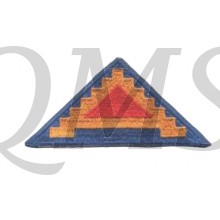Mouwembleem 7th Army (Sleeve patch 7th Army)
Seventh Army was the first U.S. Field Army to see combat during the Second World War and was activated at sea when the I Armored Corps under the command of Lt. General George Patton was redesignated on 10 July 1943. The Seventh Army landed on several beaches in southern Sicily and captured the city of Palermo on 22 July and along with theEighth British Army captured Messina on 16 August. During the fighting, the elements of the Seventh Army killed or captured over 113,000 enemy soldiers. The Headquarters elements of the Seventh Army remained relatively inactive at Palermo, Sicily, and Algiers, North Africa, until January 1944 when Lt. General Alexander Patch was assigned as commander and the Army began planning for the invasion of southern France.
The invasion was originally given the code name of Operation ANVIL but was changed to Operation DRAGOON before the landing. In March 1944, Lt. General Alexander Patch was assigned to command the Army which moved to Naples, Italy, the following July. On 15 August 1944, Seventh Army units assaulted the beaches of southern France in theSt. Tropez and Saint-Raphaël area. Within one month, the Army employing three American Divisions, five French Divisions, and the First Airborne Task Force had advanced 400 miles and had joined with the Normandy forces. In the process, the Seventh Army had liberated Marseilles, Lyon, Toulon, and all of Southern France.
Seventh Army then assaulted the German forces in the Vosges Mountains, broke into the Alsatian Plain, and reached the Rhine River after capturing the city of Strasbourg. During the Battle of the Bulge, the Seventh Army extended its flanks to take over much of the Third Army area which allowed the Third to relieve surrounded U.S. forces at Bastogne. Along with the First French Army, the Seventh went on the offensive in February 1945 and eliminated the enemy pocket in the Colmar area. The Seventh then went into the Saar River valley, crossed the Rhine, captured Nuremberg and Munich, crossed the Brenner Pass, and made contact with the Fifth Army - once again on Italian soil. In less than nine months of continuous fighting, the Seventh had advanced over 1,000 miles and for varying times had commanded 24 American and Allied Divisions, including the 36th, 42nd, 44th, 45th, 63rd,70th, 103rd, and 105th.



